Warszawa II (33 page)
Authors: Norbert Bacyk
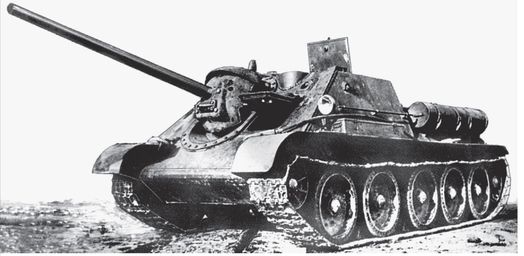
The Soviets first attempt at an effective track-propelled anti-tank gun was built on the chassis of a T-34 with an 8.5 cm gun which was effective, but almost as quickly as the T-34 was built in 1944 with a mounted 8.5 cm gun, production of the SU-85's was halted and manufacture of the even more effective SU-100 took over, a model which was used, among others, by Egypt in the Sinai War. In total 2,500 Su-85's were built during WWII.
Production period:
1943 -1944
Manufacturer:
STZ
Tonnage:
29 tonnes
Crew:
4
Length:
8 meters
Width:
3 meters
Height:
2.45 meters
Track width:
40 cm
Ground clearance:
40 cm
Motor:
W2-34 Diesel
Engine capacity:
500 HP at 1,800 rpm
Fuel capacity:
465 litres
Maximum speed:
55 km/h
Maximum range:
300 km
Armament:
1Ã 8.5 cm D-5-S-85
Ammunition quantity:
8.5 cm â 48 shells
Armour strength:
Hull frontal:
65 mm
Hull sides:
45 mm
Hull rear, roof, floor:
25 mm
Turret front:
65 mm
Turret sides:
45 mm
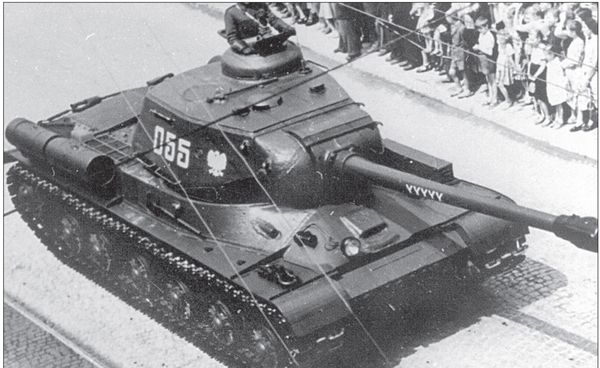
The Soviet Army had already experimented with heavy tanks prior to WWII â no model had been particularly satisfactory. The T-35 was a monster which could hardly move without breaking down. The SMK was even worse and the T-28 was too lightly armed. The KV-1 was also too lightly armed but, despite all else, with its excellent armour it performed well during 1941 and 1942. From 1943 onwards, a new heavy tank was required and it was only then that for the first time the Soviet leadership felt that they could afford to design and build a new heavy tank. The IS-1 was a new design but only had an 8.5 cm gun, the same gun as found on the new T-34/85, thus the IS-2 was developed. The vehicle in question was a further development on the KV's chassis and its track-drive suspension, but with much stronger armoured protection and much heavier armament. The vehicle was larger and slower than the T-34 but had a powerful gun which used different types of ammunition and possessed a powerful blasting capacity. It was popular among crews and was used throughout the war and even as late as 1967 in the middle-east conflict. However, there it was outclassed by more modern enemy tanks. In total 3,300 IS-2s were produced between 1944 and 1945.
Production period:
1943 â 1945
Manufacturer:
Chelyabinsk
Tonnage:
46 tonnes
Crew:
4
Length:
9.83 meters
Width:
3.07 meters
Height:
2.74 meters
Track width:
47 cm
Ground clearance:
50 cm
Motor:
W2-IS Diesel
Engine capacity:
600 hp at 2,000 rpm
Fuel capacity:
550 litres
Maximum speed:
37 km/h
Maximum range:
240 km
Armament:
1Ã 12.2 cm D-25T model 1943
2Ã 7.62 mm DT MG
1Ã 12.7 mm DShK AA MG
Ammunition quantity:
12.2 cm â 28 shells
7.62 mm â 2,300 rounds
12.7 mm â 300 rounds
Armour strength:
Hull frontal:
160 mm
Hull sides:
110 mm
Hull rear, roof, floor:
20 mm
Turret front:
160 mm
Turret sides:
110 mm
Production period:
1942 â 1943
Manufacturer:
STZ
Tonnage:
31 tonnes
Crew:
5
Length:
7 meter
Width:
3 meter
Height:
2.32 meter
Track width:
40 cm
Ground clearance:
40 cm
Motor:
W2-34 Diesel
Engine capacity:
500 HP at 1,800 rpm
Fuel capacity:
465 litres
Maximum speed:
55 km/h
Maximum range:
300 km
Armament:
1Ã 12.2 Howitzer M-30
Ammunition quantity:
12.2 cm â 40 shells
Armour strength:
Hull frontal:
65 mm
Hull sides:
45 mm
Hull rear, roof, floor:
25 mm
Turret frontal:
645 mm
Turret sides:
45 mm
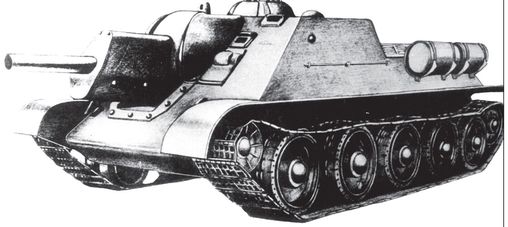
The Soviet Union's first track-driven howitzer. Just like the SU-85 it is based on the T-34 with the same chassis and engine. This howitzer transporter was effective in 1942 when it was developed. In 1943 came its successor, the SU-152, and production of the SU-122 was halted to accommodate production of the SU-85. Approximately 600 SU-122s were built in total.
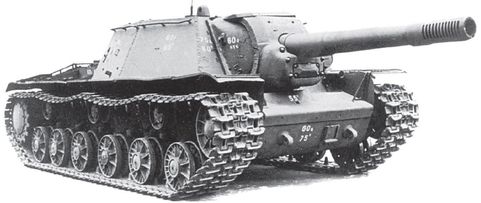
The most effective track-driven howitzer in the Red Army. Built on the chassis of the old KV-1, its armament was the massive ML-20S howitzer with a calibre of 15.24 cm. These shells “ploughed streets in the forest” according to eye-witnesses and proved to have a singularly destructive effect on Tiger and Panther tanks â thereby acquiring the nickname “Zveroboi” â “the cat killer.” 700 hundred of them were built before the chassis was changed to the IS vehicle in 1943, at which time the SU-152 changed its designation to the ISU-152.
Production period:
1943
Manufacturer:
Chelyabinsk
Tonnage:
46 tonnes
Crew:
5
Length:
9 meters
Width:
3.25 meters
Height:
2.45 meters
Track width:
47 cm
Ground clearance:
50 cm
Motor:
W2-IS Diesel
Engine capacity:
600 HP at 2,000 rpm
Fuel capacity:
550 litres
Maximum speed:
42 km/h
Maximum range:
260 km
Armament:
1Ã 15.24 cm ML-20S Howitzer
1Ã 12.7 mm MG DShK
Ammunition quantity:
15.24 cm â 20 shells
12.7 mm â 250 rounds
Armour strength:
Hull frontal:
60 mm
Hull sides:
60 mm
Hull rear, roof, floor:
25 mm
Turret front:
60 mm
Turret sides:
60 mm
Production period:
1943 â 1945
Manufacturer:
Chelyabinsk
Tonnage:
45/46 tonnes
Crew:
5
Length:
9.85/9.18 meters
Width:
3.07 meters
Height:
2.48 meters
Track width:
47 cm
Ground clearance:
50 cm
Motor:
W2-IS diesel
Engine capacity:
600 HP at 2,000 rpm
Fuel capacity:
550 litres
Maximum speed:
37 km/h
Maximum range:
220 km
Armament:
1Ã 12.2 cm D25S Howitzer (122)
1Ã 15.24 cm ML20 Howitzer (152)
1Ã 12.7 mm MG DShK (on both)
Ammunition quantity:
12.2 cm â 30 shells
15.24 cm â 20 shells
12.7 mm â 250 rounds
Armour strength:
Hull frontal:
90 mm
Hull sides:
90 mm
Hull rear, roof, floor:
25mm
Turret front:
90 mm
Turret sides:
90 mm
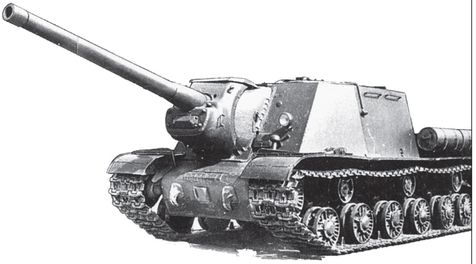
In large part, it was the same vehicle as the SU-152 although built on an IS-2 chassis. Two different versions were manufactured, the ISU-122 or ISU-152; both were equally effective as infantry support weapons, but the 122 proved to be the more effective anti-tank weapon. Note the differing specifications below. In total, 4,000 examples of both were built between 1943 and 1945.
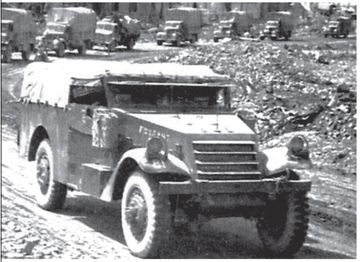
Production period:
1941 â 1944
Manufacturer:
White
Motors
Tonnage:
6 tonnes
Crew:
4
Length:
5.61 meters
Width:
2.03 meters
Height:
1.98 meters
Track width:
unavailable
Ground clearance:
40 cm
Motor:
unavailable
Engine capacity:
97 HP â rpm unavailable
Fuel capacity:
unavailable
Maximum speed:
92 km/h
Maximum range:
260 km
Armament:
1Ã 0.50 cal MG
2-3Ã 0.30 cal MG
Ammunition quantity:
0.50 cal?
0.30 cal?
Armour strength:
Hull frontal:
12 mm
Hull sides:
8 mm
Hull rear, roof, floor:
8 mm
An armoured truck, without the properties characteristic to them, is the best way of describing the M3A1. Designed to be an armoured reconnaissance vehicle was built on the chassis of a four-wheel drive lorry. So far so good, however, it was actually too big and clumsy to be an effective reconnaissance vehicle, and too weakly armoured and armed to be used as proper armoured transport. Instead it was actively utilized in wide range of roles such as a military police or command vehicle or even as an ambulance. Despite its apparent drawbacks, the Red Army regarded it as a splendid reconnaissance vehicle and equipped their cavalry corps with them. In addition, when heavily armed with up to 4 to 5 machineguns, they were effective in fighting against enemy infantry. Approximately 3,500 were sent to the Soviet Union under the lend lease programme. The American industrial sector produced approximately 18,000 vehicles of this type during the course of the war.